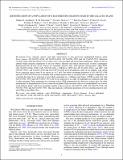| dc.contributor.author | Anderson, Gemma E. | |
| dc.contributor.author | Gaensler, Bryan M. | |
| dc.contributor.author | Kaplan, David L. | |
| dc.contributor.author | Posselt, Bettina | |
| dc.contributor.author | Slane, Patrick O. | |
| dc.contributor.author | Murray, Stephen S. | |
| dc.contributor.author | Mauerhan, Jon C. | |
| dc.contributor.author | Benjamin, Robert A. | |
| dc.contributor.author | Brogan, Crystal L. | |
| dc.contributor.author | Chakrabarty, Deepto | |
| dc.contributor.author | Drake, Jeremy J. | |
| dc.contributor.author | Drew, Janet E. | |
| dc.contributor.author | Grindlay, Jonathan E. | |
| dc.contributor.author | Hong, Jaesub | |
| dc.contributor.author | Lazio, T. Joseph W. | |
| dc.contributor.author | Lee, Julia C. | |
| dc.contributor.author | Steeghs, Danny T. H. | |
| dc.contributor.author | van Kerkwijk, Marten H. | |
| dc.date.accessioned | 2015-03-02T22:07:33Z | |
| dc.date.issued | 2011 | |
| dc.identifier.citation | Anderson, Gemma E., B. M. Gaensler, David L. Kaplan, Bettina Posselt, Patrick O. Slane, Stephen S. Murray, Jon C. Mauerhan, et al. 2011. “IDENTIFICATION OF A POPULATION OF X-RAY-EMITTING MASSIVE STARS IN THE GALACTIC PLANE.” The Astrophysical Journal 727 (2) (January 11): 105. doi:10.1088/0004-637x/727/2/105. | en_US |
| dc.identifier.issn | 0004-637X | en_US |
| dc.identifier.uri | http://nrs.harvard.edu/urn-3:HUL.InstRepos:14068420 | |
| dc.description.abstract | We present X-ray, infrared, optical, and radio observations of four previously unidentified Galactic plane X-ray sources: AX J163252-4746, AX J184738-0156, AX J144701-5919, and AX J144547-5931. Detection of each source with the Chandra X-ray Observatory has provided sub-arcsecond localizations, which we use to identify bright infrared counterparts to all four objects. Infrared and optical spectroscopy of these counterparts demonstrate that all four X-ray sources are extremely massive stars, with spectral classifications: Ofpe/WN9 (AX J163252-4746), WN7 (AX J184738-0156 = WR121a), WN7-8h (AX J144701-5919), and OIf+ (AX J144547-5931). AX J163252-4746 and AX J184738-0156 are both luminous, hard, X-ray emitters with strong Fe XXV emission lines in their X-ray spectra at ~6.7 keV. The multi-wavelength properties of AX J163252-4746 and AX J184738-0156 are not consistent with isolated massive stars or accretion onto a compact companion; we conclude that their X-ray emission is most likely generated in a colliding-wind binary (CWB) system. For both AX J144701-5919 and AX J144547-5931, the X-ray emission is an order of magnitude less luminous and with a softer spectrum. These properties are consistent with a CWB interpretation for these two sources also, but other mechanisms for the generation of X-rays cannot be excluded. There are many other as yet unidentified X-ray sources in the Galactic plane, with X-ray properties similar to those seen for AX J163252-4746, AX J184738-0156, AX J144701-5919, and AX J144547-5931. This may indicate a substantial population of X-ray-emitting massive stars and CWBs in the Milky Way. | en_US |
| dc.description.sponsorship | Astronomy | en_US |
| dc.language.iso | en_US | en_US |
| dc.publisher | IOP Publishing | en_US |
| dc.relation.isversionof | doi:10.1088/0004-637X/727/2/105 | en_US |
| dc.relation.hasversion | http://arxiv.org/pdf/1011.3295v1.pdf | en_US |
| dash.license | OAP | |
| dc.subject | stars: winds, outflows | en_US |
| dc.subject | stars: Wolf-Rayet | en_US |
| dc.subject | supergiants | en_US |
| dc.subject | X-rays: binaries | en_US |
| dc.subject | X-rays: individual (AX J163252–4746, AX J184738–0156, AX J144701–5919, AX J144547–5931) | en_US |
| dc.subject | X-rays: stars | en_US |
| dc.title | Identification of a Population of X-Ray-Emitting Massive Stars in the Galactic Plane | en_US |
| dc.type | Journal Article | en_US |
| dc.description.version | Version of Record | en_US |
| dc.relation.journal | The Astrophysical Journal | en_US |
| dash.depositing.author | Grindlay, Jonathan E. | |
| dc.date.available | 2015-03-02T22:07:33Z | |
| dc.identifier.doi | 10.1088/0004-637X/727/2/105 | * |
| dash.authorsordered | false | |
| dash.contributor.affiliated | Gaensler, Bryan | |
| dash.contributor.affiliated | Grindlay, Jonathan | |


